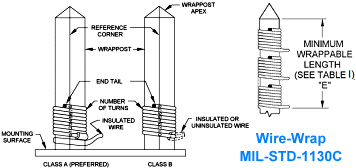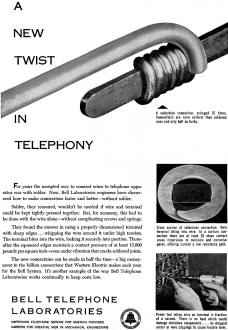|
October 1953 Radio-Electronics
 [Table of Contents] [Table of Contents]
Wax nostalgic about and learn from the history of early electronics.
See articles from Radio-Electronics,
published 1930-1988. All copyrights hereby acknowledged.
|
 After getting out of the U.S. Air Force
in 1982, I was fortunate to get a job at the Oceanic Division of Westinghouse Electric
Corporation in Annapolis, Maryland. Most of the guys who worked in the area with
me were former electronics technicians from the armed forces. We spent most of our
days (and often evenings) building small quantity specialty systems for the U.S. Navy.
The facility was fairly small and was not set up for high volume production; that
was the purview of the much larger operation based adjacent to the Baltimore / Washington
International Airport (BWI),
which built ground-based and airborne radar systems. Whilst there, I did a lot of
wire-wrap assemblies that went into MIL-SPEC systems, primarily rack-mounted equipment
in helicopters and aboard ships deploying towed sonar systems. As such, I received
extensive training for performing soldering, wire-wrapping, electrical contact crimping,
cable harness lashing, and other related skills - including how to unsolder and
unwire-wrap. The initial certification course was two or three weeks long, with
annual proficiency classes. During the class, we were given some background into
wire-wrapping including how the wire-post interface is considered to be gas-tight,
vibration-proof, and is very low resistance. Here is the 2012 version of
MIL-STD-1130C, CONNECTIONS, ELECTRICAL,
SOLDERLESS WRAPPED, where you can see what is required. The on-site Navy inspectors
examined each connection using a magnifier. If the number of turns was too low,
or the amount of slack between posts was too small, or there was a nick in a wire's
insulation, or a post had too much surface contamination, or any of a host of other
things was violated, we'd get a failure and had to re-work it. The boss was not
happy when that occurred. This same ad ran in the October 1953 issue of
Radio & Television News. After getting out of the U.S. Air Force
in 1982, I was fortunate to get a job at the Oceanic Division of Westinghouse Electric
Corporation in Annapolis, Maryland. Most of the guys who worked in the area with
me were former electronics technicians from the armed forces. We spent most of our
days (and often evenings) building small quantity specialty systems for the U.S. Navy.
The facility was fairly small and was not set up for high volume production; that
was the purview of the much larger operation based adjacent to the Baltimore / Washington
International Airport (BWI),
which built ground-based and airborne radar systems. Whilst there, I did a lot of
wire-wrap assemblies that went into MIL-SPEC systems, primarily rack-mounted equipment
in helicopters and aboard ships deploying towed sonar systems. As such, I received
extensive training for performing soldering, wire-wrapping, electrical contact crimping,
cable harness lashing, and other related skills - including how to unsolder and
unwire-wrap. The initial certification course was two or three weeks long, with
annual proficiency classes. During the class, we were given some background into
wire-wrapping including how the wire-post interface is considered to be gas-tight,
vibration-proof, and is very low resistance. Here is the 2012 version of
MIL-STD-1130C, CONNECTIONS, ELECTRICAL,
SOLDERLESS WRAPPED, where you can see what is required. The on-site Navy inspectors
examined each connection using a magnifier. If the number of turns was too low,
or the amount of slack between posts was too small, or there was a nick in a wire's
insulation, or a post had too much surface contamination, or any of a host of other
things was violated, we'd get a failure and had to re-work it. The boss was not
happy when that occurred. This same ad ran in the October 1953 issue of
Radio & Television News.
| Bell Telephone
Laboratories Infomercials |
-
The Future Holds Great Promise
- August 1949 Popular Science
-
Waveguide: 7/47 Popular Mechanics
-
Wire Wrapping - 10/1953 Popular Science
-
X-Rays, 4/60 Radio-electronics
- The Battle of
the Atoms, 4/1948 Radio News
-
The Transistor, 6/1952 Radio-Electronics
- 90-Mile Laboratory
for Telephone and Television, 6/1945 Radio News
-
Wire-Wrap, 10/53 Radio-Electronics
-
EDT Crystals, 10/47 Radio-Craft
- Germanium Refining,
5/54 Radio & TV News
- Crystal Timekeeping,
1/46 Radio News
- Transatlantic
Cable, 11/56 Radio & Television News
- Pipe Circuits,
11/48 Radio & Television News
-
Coaxial
Electron Tube, 6/54 Radio & Television News
- Thermocompression
Wire Bonding, 3/58 Radio News
-
Radio Relay Stations, 8/52 Radio & Television News
- Isolators,
6/56 Radio & Television News
- Punch
Cards, 3/55 Radio & Television News
-
Over-the-Horizon
Communications, 10/55 Radio & Television News
- Memory
Devices, 2/58 Radio & TV News
-
Adventure in Silicon, 5/55 Radio & Television News
- Pipes of Progress,
6/55 Radio & Television News
-
Project Echo, 11/60 Electronics World
|
-
Jacques Bernoulli, February 1960 Radio-Electronics
-
Type-O Carrier System, October 1952 Radio-Electronics
-
Electron Microscope, 4/1952 Radio-Electronics
-
Thermistor, 11/1946 Radio-Craft
-
Germanium Crystal, 1/1954 Radio-Electronics
-
Lens
Antenna, 5/46 Radio-Craft
- Quality Control, 6/46
Radio News Article
- Transcontinental
Radio-Relay, 10/51 Radio & TV News
- Solar
Battery, 7/54 Radio & Television News
-
Germanium Transistors, 1/54 Radio & Television News
- Cavity
Magnetron, 10/45 Radio News
-
The Cableman, 10/49 Radio & Television News
-
Coaxial Cable, 12/49 Radio & Television News
-
Tin
Whiskers, 12/55 Radio & Television News
- Relay
Contact Inspection, 7/55 Radio & Television News
- Transistor's
10th Anniversary, 6/58 Radio & Television News
-
Wire
Wrapping, 10/53 Radio & Television News
- Junction
Diode Amplifier, 11/58 Radio News
-
Nobel Prize Winners, 2/57 Radio & Television News
-
Diode Speeds Voices, 8/58 Popular Electronics
-
Microwave Relays, 7/59 Electronics World
|
Bell Telephone Laboratories - A New Twist in Telephony
 A solderless connection, enlarged 15 times.
Connections are more uniform than soldered ones and only half as bulky. A solderless connection, enlarged 15 times.
Connections are more uniform than soldered ones and only half as bulky.
For years the accepted way to connect wires to telephone apparatus was with solder.
Now, Bell Laboratories engineers have discovered how to make connections faster
and better - without solder.
Solder, they reasoned, wouldn't be needed if wire and terminal could be kept
tightly pressed together. But, for economy, this had to be done with the wire alone
- without complicating screws and springs.
They found the answer in using a properly dimensioned terminal with sharp edges
... whipping the wire around it under high tension. The terminal bites into the
wire, locking it securely into position. Thereafter the squeezed edges maintain
a contact pressure of at least 15,000 pounds per square inch - even under vibration
that cracks soldered joints.
The new connections can be made in half the time - a big money-saver in the billion
connections that Western Electric makes each year for the Bell System. It's another
example of the way Bell Telephone Laboratories works continually to keep costs low.
Bell Telephone Laboratories
Improving Telephone Service for America Provides Careers for Creative men in
Mechanical Engineering
Cross section of solderless connection. Note terminal biting into wire. In a
six-turn connection there are at least 20 clean contact areas impervious to moisture
and corrosive gases, offering current a low resistance path.
Power tool whips wire on terminal in fraction of a second. There is no heat which
could damage miniature components ... no dropped solder or wire clippings to cause
trouble later.
Posted November 10, 2020
|


